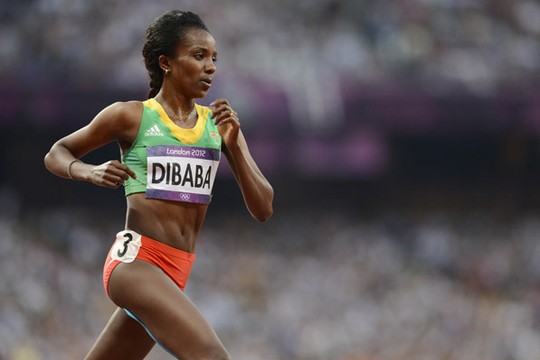Congratulations to everyone who competed over the weekend whether it was at Crystal Palace or at the West Reservoir. I watched our team compete in the Crystal Palace Triathlon and it was awesome! Ellen Greaves and Sarah Allen were separated by just 14 seconds and placed 3rd and 4th overall. Scott Miller, Adam Parkes and Guy Holbrow were 10th, 11th and 12th overall and were separated by just 26 seconds. Guy was 3rd in the V40 category. It was the effort put in by all those who competed that pushed everyone to post such great times. LFTC remain second in the London League and the dream of finishing on the podium this year stays alive!
OK, so you don’t have to watch the whole video although I could watch this over and over again just because running form fascinates me and Tirunesh Dibaba is one of the greatest female distance runners of all time. Even in a world class field of specialist 10000m runners you will see quite a lot of variation in technique. Focus your attention on the Ethiopian runner with the number 16 on her shorts, Tirunesh Dibaba running ‘beautifully smoothly’ as the commentator says.

Tirunesh Dibaba, London 2012, Olympic 10000m Champion.
For the untrained eye perhaps one of the most obvious aspects of running technique to critique is arm swing. How many of the athletes in the field do you see with a 90 degree bend at the elbow? Not many. Yet how many times do you read in running related literature that your elbow should be held at 90 degrees? The elbow might approach 90 degrees as the arm moves towards the end of the backswing and the angle at the elbow opens slightly but it is not ‘held’ in this position. As the arm swings forward the angle at the elbow closes.
You will probably notice that Tirunesh Dibaba (and most of the African athletes) does not even get close to 90 degrees. Contrast this style with the arm swing of the three Japanese athletes who took the early lead. You will see two very contrasting techniques. If you look closely you will probably see subtle differences in stride characteristics which are being reflected in the arm swing. Notice also the importance of the backswing of the arms relative to the forward swing. The elbows move a lot further behind the body than they do in front of the body. Of course we must remember that these women are running an average of just over 3mins/km and sometimes a lot faster than this!
So should everyone run in exactly the same way? If we were anatomically identical, all grew up running barefoot, if we were running at the same pace and on the same terrain then yes we probably would run the same way. But we are all different so there are some general principles that will apply to all of us but we must also consider our individual differences and how this will influence our running technique. An experienced coach will identify those factors peculiar to the individual that may have a negative effect on their performance or put them at risk of injury and then attempt to help the athlete correct them. He or she will also identify factors peculiar to the individual that can be trained to improve performance.
When you watch someone running it is useful to make some very general observations with regard to the following:
- Posture
- Rhythm and timing
- Relaxation
Posture:
Good runners have an upright posture. If there is a forward lean it is very slight and comes from the ankle rather than from the hips or spine. The spine maintains its natural curves as seen when standing with correct posture.
Rhythm and timing:
Watch any top level athlete in any sport and one thing that sets them apart from novice athletes is rhythm and timing. When it comes to running the arms and legs are timed perfectly, as the stance leg (the one in contact with the ground) reaches maximum extension (movement of the leg behind the body) the opposite arm reaches maximum flexion (movement of the arm in front of the body). The shift from swing phase (when the foot is off the ground) to the contact phase is seamless no matter what pace the athlete chooses to run at.
Relaxation:
When watching Tirunesh Dibaba you will see how she makes running look effortless through her relaxation. It is of course not effortless. She is able to generate forward propulsion using only those muscles that need to be working and with just the right amount of activation to maximise efficiency and economy while maintaining relaxation in those areas that do not have to be generating force.
So next time you are out for a run, have a think about your posture, rhythm and timing and relaxation. I think relaxation in the face and hands is key. This will flow through to the rest of the body. Have a fantastic long weekend! Tim (LFTC Coach).